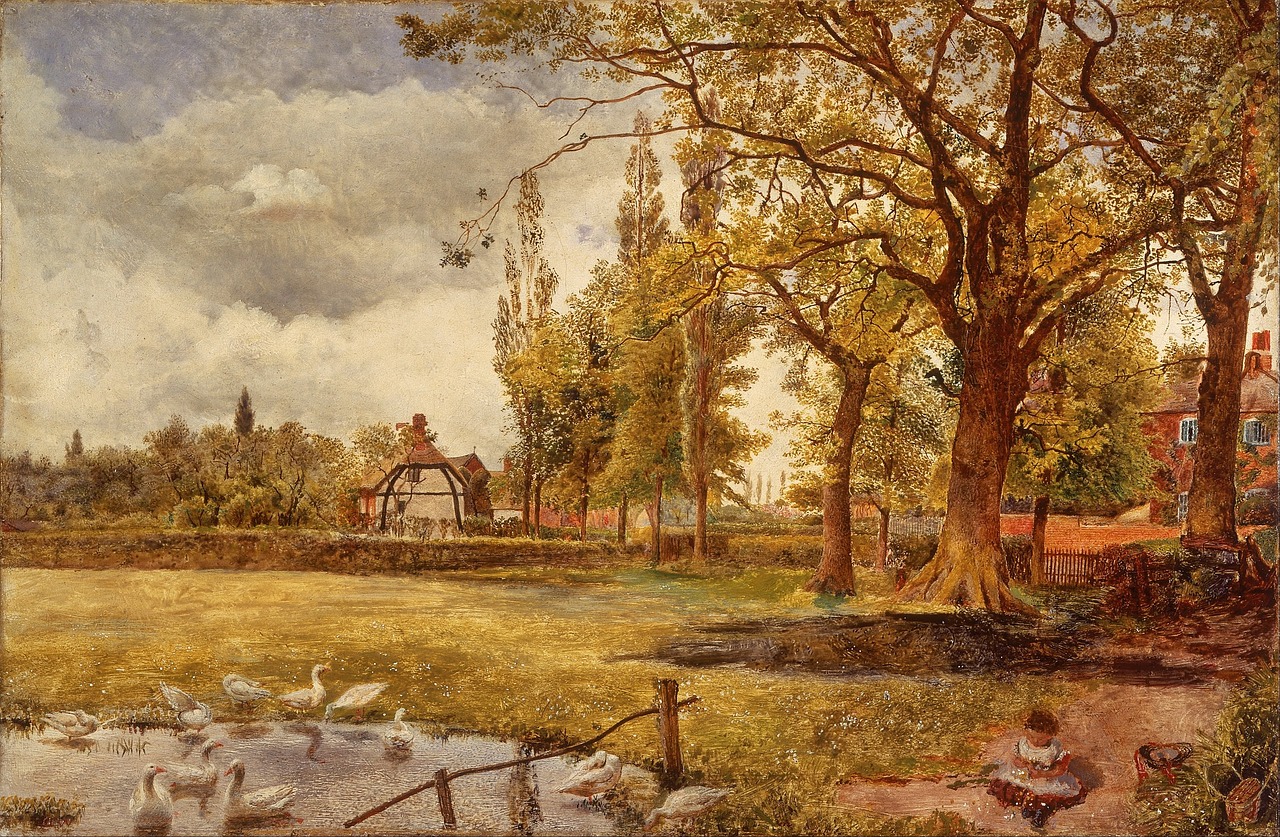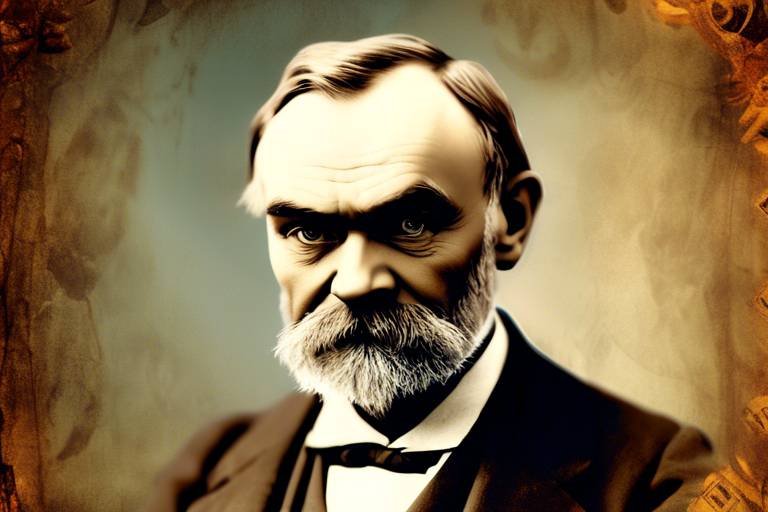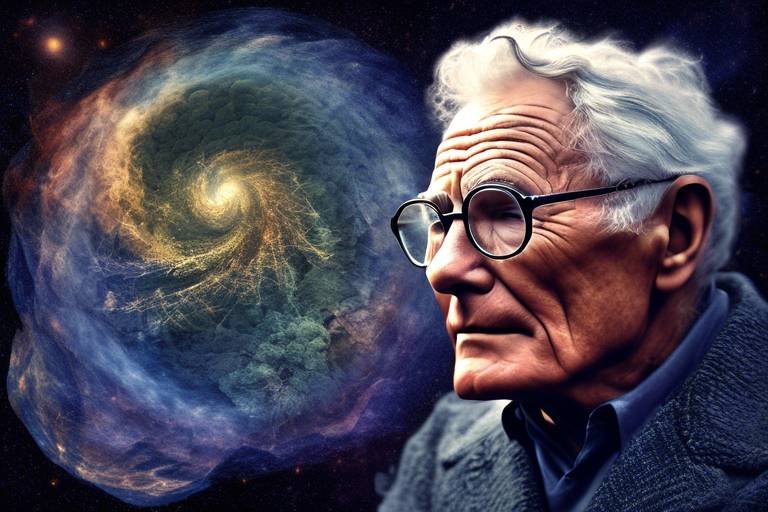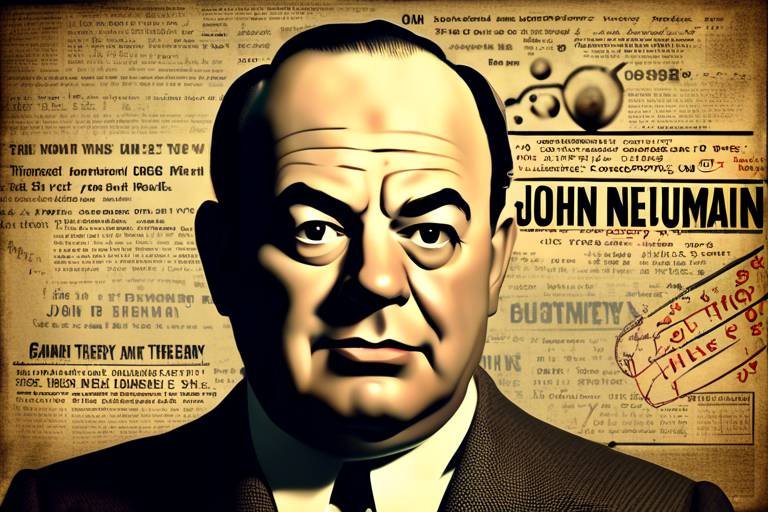The Life of William Harvey and Circulation of Blood
William Harvey, a name that resonates through the corridors of medical history, is renowned for his revolutionary discoveries regarding the circulation of blood. Born in 1578 in Folkestone, England, Harvey's journey was anything but ordinary. His relentless quest for knowledge and understanding of the human body set the stage for a monumental shift in physiology. Imagine living in a time when the very notion of blood circulation was a mystery! Harvey not only cracked that code but also laid the groundwork for modern medicine. This article explores his remarkable life, his groundbreaking discoveries, and the profound impact of his work on the understanding of blood circulation.
William Harvey's formative years were pivotal in shaping his future contributions to medicine. Growing up in a modest family, he was the eldest of nine children. His father, a successful merchant, ensured that Harvey received a good education. He attended the King's School in Canterbury and later went on to study at Cambridge University. It was here that Harvey first encountered the wonders of science and medicine. His passion for studying the human body was ignited, leading him to further his studies at the University of Padua in Italy, which was a hub for medical knowledge at the time. Imagine the excitement of being in a city that was bustling with intellectual activity, where the likes of Vesalius and Galileo had walked the same streets!
After completing his education, Harvey returned to England and began his medical career at St. Bartholomew's Hospital in London. His early practice was marked by a keen interest in anatomy and physiology, which he honed through meticulous observation and dissection. Harvey's experiences during this period were crucial; they provided him with a solid foundation in understanding the human body. He was not merely a practitioner; he was a keen observer, often challenging the conventional wisdom of his time. This approach would later serve him well as he ventured into groundbreaking research.
The Renaissance was a time of intellectual awakening, and Harvey was influenced by several key figures who reshaped the landscape of science. Thinkers like Andreas Vesalius and Galileo Galilei played significant roles in inspiring Harvey's approach to scientific inquiry. They emphasized observation, experimentation, and questioning established norms. Harvey's ability to synthesize their ideas into his own work marked a turning point in his understanding of human physiology.
Andreas Vesalius, often referred to as the father of modern anatomy, made significant contributions that greatly influenced Harvey. His meticulous dissections and detailed anatomical drawings challenged the long-held beliefs propagated by Galen. Vesalius's emphasis on observation and accuracy inspired Harvey to delve deeper into the study of anatomy, particularly the cardiovascular system. Harvey built upon Vesalius's work, recognizing that understanding the structure of the heart and blood vessels was essential for uncovering the mysteries of blood circulation.
Galileo's emphasis on empirical observation and the scientific method also left a lasting impact on Harvey's work. The idea that one should rely on direct observation rather than accepted dogma resonated with Harvey. He adopted these principles, conducting experiments and making observations that would lead him to challenge existing medical beliefs. Imagine the courage it took to go against the grain in a time when the established medical community was resistant to change!
Harvey's groundbreaking discovery of blood circulation came about through a series of meticulous experiments and keen observations. By studying the heart's function and the movement of blood through veins and arteries, he formulated a theory that contradicted centuries of accepted beliefs. He demonstrated that blood circulates in a closed system, pumped by the heart, rather than being consumed by the body as previously thought. This revelation was nothing short of revolutionary, akin to discovering a hidden treasure chest in a world full of myths!
In 1628, Harvey published his seminal work, 'De Motu Cordis' (On the Motion of the Heart), which laid out his findings in detail. This publication was not just a scientific text; it was a manifesto that changed the course of medicine. Harvey meticulously detailed his observations and experiments, providing evidence for his theory of blood circulation. The significance of this work cannot be overstated; it cemented his legacy in the medical community and inspired future generations of scientists and physicians to explore the wonders of the human body.
However, not everyone was ready to embrace Harvey's revolutionary ideas. His theories were met with skepticism and resistance from contemporaries who were entrenched in traditional beliefs. Many dismissed his findings as radical and unfounded, leading to heated debates within the medical field. Harvey's unwavering commitment to his research, despite the backlash, is a testament to his character and determination. He stood firm in his convictions, much like a lighthouse guiding ships through turbulent waters.
William Harvey's contributions laid the foundation for modern physiology and our understanding of the cardiovascular system. His work not only transformed medical science but also influenced the evolution of cardiovascular studies for centuries to come. Today, we recognize Harvey as a pioneer whose insights continue to shape contemporary science. His legacy is evident in every heartbeat we monitor, every surgical procedure we perform, and every life we save through the understanding of blood circulation.
- What was William Harvey's major contribution to medicine? Harvey is best known for discovering the circulation of blood, demonstrating that blood circulates in a closed system, pumped by the heart.
- When did Harvey publish his findings? He published his seminal work, 'De Motu Cordis', in 1628, detailing his observations and experiments on blood circulation.
- How did Harvey's work influence modern medicine? Harvey's discoveries laid the groundwork for modern physiology and have had a lasting impact on the study of the cardiovascular system.

Early Life and Education
William Harvey was born in 1578 in Folkestone, England, into a family that valued education and intellectual pursuit. His father, a prosperous merchant, ensured that Harvey received a solid education from a young age. This upbringing played a crucial role in shaping his future contributions to medicine. Imagine a young boy, curious about the world around him, constantly asking questions about how things work—this was Harvey. His early fascination with nature and the human body set the stage for his groundbreaking discoveries.
At the age of 15, Harvey enrolled at Gonville and Caius College, Cambridge, where he studied for a Bachelor of Arts degree. The college was known for its rigorous academic environment, and it was here that Harvey was exposed to a variety of subjects, including philosophy and natural sciences. This diverse education ignited his interest in the complexities of the human body and laid the groundwork for his later studies in medicine.
After completing his degree in 1597, Harvey pursued further studies in medicine at the University of Padua in Italy, which was renowned for its advancements in anatomical science. The vibrant atmosphere of the university, filled with intellectual discourse and innovative ideas, was pivotal for Harvey. He was deeply influenced by the works of prominent figures such as Andreas Vesalius, whose meticulous studies on human anatomy challenged the long-held beliefs of Galen. This exposure to cutting-edge ideas and methodologies not only honed Harvey's skills but also inspired him to adopt a more empirical approach to medicine.
During his time in Padua, Harvey was captivated by the idea that observation and experimentation could lead to a deeper understanding of the human body. He often participated in dissections, where he meticulously examined the anatomy of various animals, which would later inform his groundbreaking theories. This hands-on experience was invaluable, as it allowed him to challenge existing medical doctrines and develop his unique perspective on physiology.
Upon returning to England, Harvey continued to build on his education and experiences. He became a fellow of the Royal College of Physicians in 1607, where he was able to share his knowledge and insights with other medical professionals. His early career was marked by a relentless pursuit of knowledge, and he often engaged in discussions with fellow physicians and scholars, further refining his understanding of the human body.
In summary, William Harvey's early life and education were characterized by a strong foundation in the sciences, a thirst for knowledge, and an unwavering curiosity about the human body. These formative years not only shaped his future discoveries but also set him on a path that would ultimately revolutionize the understanding of blood circulation. His journey from a curious young boy to a pioneering physician exemplifies the importance of education and intellectual exploration in the pursuit of scientific advancement.

Medical Career Beginnings
William Harvey's journey into the world of medicine was anything but ordinary. After completing his studies at the University of Padua, where he was exposed to the revolutionary ideas of the Renaissance, Harvey returned to England with a burning desire to explore the intricacies of the human body. His early medical career began in London, where he took up a position as a physician at St. Bartholomew's Hospital. Here, he was not just a doctor; he was a keen observer, a role that would prove pivotal in his future discoveries.
During his time at St. Bartholomew's, Harvey's passion for anatomy and physiology blossomed. He immersed himself in the study of human cadavers, which was somewhat controversial at the time. This hands-on experience allowed him to challenge the prevailing medical theories that were steeped in ancient texts rather than empirical evidence. Harvey's relentless curiosity and dedication to understanding the body from a practical standpoint set him apart from his contemporaries.
As he honed his skills, Harvey began to develop a reputation for his innovative approaches to diagnosis and treatment. He was particularly fascinated by the heart and its role in the body, which led him to conduct numerous dissections and experiments. His observations were meticulous, and he often documented his findings in detail. For instance, he noted the movement of blood and the pulse in various patients, which would later become crucial in his groundbreaking theories.
Moreover, Harvey's medical career was enriched by his interactions with other prominent figures of the time. He frequently collaborated with surgeons and anatomists, exchanging ideas that would shape his understanding of circulation. This environment of intellectual exchange was vital; it was a melting pot of ideas that pushed the boundaries of medical knowledge. Harvey's early experiences in the bustling medical scene of London, coupled with his relentless pursuit of knowledge, laid the groundwork for his later discoveries that would forever change the landscape of medicine.
As he navigated his medical career, Harvey also faced challenges that tested his resolve. The medical community was still heavily influenced by ancient authorities, and many practitioners were resistant to change. However, Harvey's confidence in his observations and experiments fueled his determination to pursue the truth. His early years in medicine were not just about treating patients; they were about laying the foundation for a revolutionary understanding of the human body that would eventually lead him to the discovery of blood circulation.
In summary, William Harvey's medical career beginnings were characterized by a blend of rigorous education, hands-on experience, and a thirst for knowledge. His time at St. Bartholomew's Hospital and his interactions with other medical professionals played a crucial role in shaping his revolutionary ideas. It was during these formative years that Harvey began to question established beliefs, setting the stage for his groundbreaking work in the field of physiology.

Influence of Renaissance Thinkers
The Renaissance was a vibrant period that ignited a spark of curiosity and inquiry in various fields, including science and medicine. For William Harvey, this era was not just a backdrop; it was a catalyst that significantly shaped his approach to understanding the human body. Imagine a world where the mysteries of anatomy were still wrapped in ancient dogma, where asking questions was often frowned upon. Harvey, however, was fortunate to be inspired by a cadre of brilliant minds that challenged the status quo and paved the way for revolutionary ideas.
Among these thinkers, Andreas Vesalius stands out as a towering figure. His meticulous work on human anatomy, particularly his book 'De humani corporis fabrica,' laid the groundwork for a more accurate understanding of the human body. Vesalius's insistence on direct observation and dissection contradicted the long-held beliefs based on Galen's theories, which were often derived from animal studies. Harvey absorbed Vesalius's principles, realizing that to truly understand blood circulation, he needed to observe the human body firsthand.
Another significant influence came from the realm of physics, particularly from the renowned scientist Galileo Galilei. Galileo's emphasis on empirical observation and the scientific method resonated deeply with Harvey. He adopted this rigorous approach, believing that mere speculation would not suffice to unlock the mysteries of blood flow. Harvey's experiments were not just about collecting data; they were about challenging existing beliefs and proving them wrong through careful observation and reasoning. This methodical approach allowed him to gather evidence that would eventually lead to his groundbreaking discovery of blood circulation.
In addition to Vesalius and Galileo, Harvey was also influenced by other Renaissance thinkers who emphasized the importance of inquiry and skepticism. The environment of intellectual freedom encouraged him to question everything he had learned and to seek answers through experimentation. This period was characterized by a shift from dogmatic adherence to ancient texts toward a more evidence-based approach to science. Harvey's ability to synthesize these influences into his work was crucial in developing his revolutionary theories.
Ultimately, the Renaissance thinkers provided not just knowledge, but a framework for inquiry that empowered Harvey to explore the unknown. Their legacy was not merely academic; it was a profound shift in how medicine was practiced and understood. By embracing the spirit of the Renaissance, Harvey was able to embark on a journey that would change the course of medical history forever.
- Who was William Harvey?
William Harvey was a 17th-century physician who discovered the circulation of blood in the human body, fundamentally changing the understanding of human physiology. - What was the significance of 'De Motu Cordis'?
'De Motu Cordis,' published in 1628, was Harvey's groundbreaking work that detailed his theories on blood circulation, establishing him as a pivotal figure in medicine. - How did Renaissance thinkers influence Harvey?
Renaissance thinkers like Andreas Vesalius and Galileo Galilei inspired Harvey to adopt empirical methods and challenge existing medical beliefs, shaping his revolutionary discoveries. - What impact did Harvey have on modern medicine?
Harvey's work laid the foundation for modern cardiovascular studies and physiology, influencing countless medical practices and research in the centuries that followed.

Andreas Vesalius and Anatomy
Andreas Vesalius, often hailed as the father of modern anatomy, played a pivotal role in shaping the medical landscape that William Harvey would later navigate. Born in 1514 in Brussels, Vesalius challenged centuries of anatomical misconceptions that had been perpetuated by ancient texts, particularly those of Galen. His meticulous approach to dissection and observation laid the groundwork for a more accurate understanding of the human body. Imagine a world where medical students relied on secondhand information rather than firsthand experience—this was the reality before Vesalius stepped onto the scene.
Vesalius's groundbreaking work, “De humani corporis fabrica” (On the Fabric of the Human Body), published in 1543, was a game-changer. It was not just a book; it was a revolution. For the first time, detailed illustrations and descriptions of human anatomy were based on real dissections rather than the flawed interpretations of earlier scholars. This shift from theory to practice was crucial for Harvey, who would later build upon Vesalius's findings to explore the mysteries of blood circulation.
What made Vesalius's contributions so significant? Here are a few key points:
- Direct Observation: Vesalius emphasized the importance of observing the human body directly through dissections, which contradicted the reliance on ancient texts.
- Illustrative Detail: His anatomical drawings were not only accurate but also artistically compelling, making them accessible and educational for medical students.
- Correcting Misconceptions: Vesalius corrected numerous errors made by Galen, particularly regarding the structure of the heart and the vascular system, which directly influenced Harvey’s later work.
Harvey, inspired by Vesalius, adopted this empirical approach. He understood that to unveil the secrets of blood circulation, one must dissect not just the body but also the prevailing theories of the time. Vesalius's insistence on firsthand observation became a cornerstone of Harvey's methodology. It was as if Vesalius handed Harvey a key to unlock the door to understanding the circulatory system.
In essence, Vesalius's legacy was not merely in the anatomical knowledge he provided but in the spirit of inquiry and skepticism he instilled in future generations of physicians. Harvey's work on blood circulation can be seen as a direct continuation of Vesalius's quest for truth in medicine. The meticulous attention to detail and the courage to question established norms are qualities that defined both men and their contributions to science.
As we delve deeper into Harvey's discoveries, it becomes clear that the path was paved by the revolutionary insights of Vesalius. His work not only illuminated the human body but also ignited a passion for scientific exploration that would resonate through the ages.

Galileo and Scientific Method
When we think about the giants of science, Galileo Galilei often comes to mind, and for good reason. His contributions to the scientific method were nothing short of revolutionary. Harvey, living during this remarkable period of intellectual exploration, was deeply influenced by Galileo's emphasis on observation and experimentation. Imagine a world where medical practices were based more on tradition than on evidence; that was the reality before Galileo's time. He challenged this status quo, advocating for a systematic approach to understanding the natural world.
Galileo's insistence on empirical evidence laid the groundwork for modern science. He believed that knowledge should be derived from measurable and observable phenomena, a principle that Harvey adopted in his own studies of blood circulation. For instance, while many of Harvey's contemporaries relied on ancient texts and dogma, Harvey took to the dissection table, observing the heart and its functions firsthand. This hands-on approach was a direct reflection of Galileo's teachings, which encouraged questioning established beliefs and seeking truth through direct observation.
One of the most significant aspects of Galileo's influence on Harvey was the concept of hypothesis testing. Galileo famously conducted experiments, such as dropping spheres of different weights from the Leaning Tower of Pisa, to demonstrate that they fell at the same rate. This method of testing hypotheses through experimentation inspired Harvey to formulate his own theories regarding blood flow. He meticulously observed the heart's contractions and the valves in veins, leading him to propose that blood circulates in a closed system, much like the way Galileo described motion and inertia.
In addition to his experimental methods, Galileo also emphasized the importance of mathematics in understanding the natural world. He believed that the universe was governed by mathematical laws, a notion that resonated with Harvey as he sought to quantify the movements of blood throughout the body. Harvey's work was not just a series of observations; it was a mathematical exploration of how blood circulated, laying the groundwork for future research in physiology.
In summary, Galileo’s influence on William Harvey cannot be overstated. Through his pioneering spirit and methodological rigor, Galileo inspired a generation of thinkers, including Harvey, to embrace a new way of understanding the human body. The shift from reliance on ancient texts to a focus on observation and experimentation marked a pivotal moment in the history of medicine, one that continues to resonate to this day.

Discovery of Blood Circulation
The journey of William Harvey towards discovering blood circulation was nothing short of revolutionary. Imagine a time when the very essence of life—blood—was shrouded in mystery. Before Harvey, the prevailing belief was that blood was produced in the liver and consumed by the body like fuel. This misconception was deeply rooted in the teachings of ancient scholars, and it took a mind as curious and determined as Harvey's to unravel this intricate puzzle.
Harvey's fascination with the human body began during his medical studies at the University of Padua, where he was exposed to the groundbreaking work of Andreas Vesalius. Vesalius had challenged the long-held anatomical misconceptions of his time, and Harvey was inspired to dig deeper. He began to conduct meticulous observations and experiments, focusing particularly on the heart and its function. Through careful dissection and observation, Harvey started to see the heart not just as a pump, but as a central organ that played a critical role in the circulatory system.
One of Harvey's key experiments involved the examination of the heart's valves. He noticed that these valves only allowed blood to flow in one direction, which was a crucial observation. This led him to hypothesize that blood circulates in a closed system, continuously moving through the body rather than being produced anew. To illustrate his theory, Harvey famously used the analogy of a waterwheel: just as water flows in a continuous loop, so too does blood circulate throughout the body.
To further solidify his theory, Harvey conducted experiments on various animals, carefully tracking the movement of blood. He observed that when he clamped certain blood vessels, the blood flow was affected, which provided concrete evidence supporting his claims. His experiments were not just theoretical; they were practical demonstrations that challenged the status quo of medical understanding.
In his groundbreaking work, he detailed how the heart pumps blood into the arteries, which then travels throughout the body, returning via the veins. This was a radical departure from the earlier belief that blood was merely consumed in the body. The implications of his findings were profound, as they laid the groundwork for modern physiology and our understanding of the cardiovascular system.
Harvey's discovery did not come without its challenges. His ideas were met with skepticism and resistance from many established physicians who were reluctant to abandon centuries of tradition. Yet, the evidence he presented was undeniable, and over time, the medical community began to embrace his revolutionary ideas. The acceptance of his work marked a pivotal moment in the history of medicine, shifting the focus from speculative theories to empirical observation and experimentation.
In conclusion, Harvey's discovery of blood circulation was not just a scientific breakthrough; it was a catalyst for change in medical thought. His meticulous approach to anatomy and physiology paved the way for future generations of scientists and doctors, transforming our understanding of the human body. The circulatory system, once a mystery, became a well-mapped territory, thanks to the pioneering spirit of William Harvey.

Publication of 'De Motu Cordis'
In the year 1628, William Harvey made a monumental stride in the field of medicine with the publication of his groundbreaking work, 'De Motu Cordis', which translates to 'On the Motion of the Heart'. This publication was not just a book; it was a revolutionary manifesto that challenged the long-standing beliefs about the circulatory system. Harvey's meticulous research and observations culminated in a theory that proposed the heart as a central pump, propelling blood throughout the body in a closed circuit. Can you imagine the audacity it took to stand against centuries of accepted medical doctrine?
Harvey's work was a culmination of years spent observing the anatomy of various animals and conducting experiments that would seem radical for his time. He meticulously documented his findings, providing clear evidence that blood circulates continuously rather than being consumed by the body as previously thought. To convey his ideas effectively, Harvey utilized a combination of empirical observation and logical reasoning, which was a hallmark of the emerging scientific method of the Renaissance. The clarity and precision of his writing invited both intrigue and skepticism.
One of the most striking features of 'De Motu Cordis' is how Harvey structured his arguments. He began by laying the groundwork with established knowledge, gradually leading readers to his revolutionary conclusions. This method was not merely about presenting facts; it was about engaging the reader in a process of discovery. The book is divided into several sections, each building upon the last, which made it accessible to both scholars and practitioners of medicine.
| Key Sections of 'De Motu Cordis' | Overview |
|---|---|
| Introduction | Sets the stage for the discussion on the heart and blood circulation. |
| Observations on the Heart | Details the structure and function of the heart based on dissections. |
| Blood Flow Dynamics | Explains the concept of blood circulating in a closed loop. |
| Conclusion | Summarizes the implications of his findings for medicine. |
Despite the scientific rigor of 'De Motu Cordis', the reception was far from warm. Many contemporaries viewed Harvey's theories with skepticism, as they contradicted the long-held beliefs established by Galen and others. Critics argued that the heart was merely a passive organ, and the idea of a circulatory system was too radical to accept. However, Harvey remained undeterred, confident in the validity of his findings. His relentless pursuit of truth in the face of opposition is a testament to his character and commitment to science.
In summary, the publication of 'De Motu Cordis' not only marked a pivotal moment in Harvey's career but also laid the groundwork for modern physiology. It ignited a wave of inquiry and debate that would eventually lead to a deeper understanding of the human body. Harvey's legacy, encapsulated in this seminal work, continues to resonate in contemporary medicine, reminding us of the importance of questioning established norms and seeking knowledge through observation and experimentation.
- What was the main discovery of William Harvey? Harvey discovered that blood circulates in a closed loop, pumped by the heart.
- Why was 'De Motu Cordis' significant? It challenged existing medical beliefs and laid the foundation for modern physiology.
- How did Harvey's work influence future medical research? His empirical approach and emphasis on observation paved the way for future scientific methods.

Reception and Controversy
When William Harvey unveiled his revolutionary ideas about blood circulation in his 1628 publication, 'De Motu Cordis', the medical community was far from welcoming. Instead of accolades, Harvey faced a storm of skepticism and outright hostility. Imagine presenting a groundbreaking theory that challenges centuries of accepted beliefs—this was the reality for Harvey. His assertion that blood circulated continuously through the body, propelled by the heart, contradicted the long-held notion that blood was produced in the liver and consumed by the body like fuel. The audacity of his claims was met with a mix of intrigue and disdain.
Many of Harvey's contemporaries, entrenched in traditional Galenic medicine, were not ready to embrace such a radical shift. They questioned his methods and the validity of his findings. Critics argued that Harvey's conclusions were based on insufficient evidence, as he had conducted most of his experiments on animals rather than humans. This led to heated debates in medical circles, where established practitioners defended the status quo while Harvey's supporters championed his innovative approach. The clash between old and new ideas created a palpable tension in the field of medicine.
To illustrate the divide, consider the following table that summarizes the contrasting views of Harvey's supporters and detractors:
| Supporters' Views | Detractors' Views |
|---|---|
| Emphasized empirical evidence from experiments | Claimed insufficient evidence and reliance on animal studies |
| Praised the revolutionary nature of his work | Argued that his theories contradicted established medical practices |
| Believed in the potential for further discoveries in physiology | Feared the implications of abandoning traditional medical teachings |
Despite the backlash, Harvey's work gradually gained traction. As more physicians began to conduct their own observations and experiments, the evidence supporting Harvey's theory became harder to ignore. Over time, his ideas permeated the medical community, laying the groundwork for modern physiology. The initial resistance to Harvey's work serves as a powerful reminder of how revolutionary ideas often face scrutiny before being accepted. The legacy of this controversy highlights not only Harvey's courage to challenge the norm but also the slow evolution of scientific understanding.
In the end, Harvey's persistence paid off. His contributions paved the way for future explorations in cardiovascular medicine and established a new paradigm in the understanding of human anatomy. The controversy surrounding his work ultimately underscored the importance of questioning established beliefs and embracing scientific inquiry, a lesson that resonates in today's medical field.
- What was William Harvey's major discovery?
Harvey discovered the circulation of blood, proposing that it moves continuously through the body, pumped by the heart. - How did the medical community initially react to Harvey's ideas?
His ideas were met with skepticism and resistance, as they contradicted long-held beliefs in medicine. - What is the significance of 'De Motu Cordis'?
This seminal work established Harvey’s theories on blood circulation and laid the foundation for modern physiology. - Why was Harvey's work controversial?
His reliance on animal studies and the challenge to traditional medical practices led to significant debate and controversy.

Legacy and Impact on Medicine
William Harvey's contributions to medicine are nothing short of revolutionary. His discovery of blood circulation not only changed the way we understand the human body but also laid the groundwork for numerous advancements in medical science. Before Harvey, the concept of blood movement was shrouded in mystery and misconceptions. His meticulous observations and experiments provided clarity to a complex subject, transforming the field of physiology.
One of the most significant impacts of Harvey's work was the shift from speculative theories to empirical science. He championed the importance of observation and experimentation, encouraging future generations of scientists to rely on data rather than conjecture. This methodological approach became a cornerstone of modern scientific inquiry and is evident in various fields today, from biology to physics.
Harvey's legacy extends beyond his immediate findings. His work paved the way for further research into the cardiovascular system, leading to a deeper understanding of heart diseases, blood disorders, and the overall functioning of the circulatory system. Today, we rely on Harvey's principles in various medical practices, including surgeries and treatments that involve the heart and blood vessels.
Moreover, Harvey's influence can be seen in the education of medical professionals. His emphasis on anatomy and physiology has become integral to medical curricula worldwide. Students are taught to appreciate the importance of observation and critical thinking, values that Harvey embodied throughout his career.
To illustrate the profound impact of Harvey's work, let’s take a look at some key areas of medicine that have evolved due to his discoveries:
| Area of Medicine | Impact of Harvey's Work |
|---|---|
| Cardiology | Foundation for understanding heart function and diseases. |
| Physiology | Established principles of blood flow and circulation. |
| Surgery | Improved techniques and understanding of blood loss and transfusions. |
| Medical Education | Incorporation of empirical methods and anatomy into curricula. |
In conclusion, William Harvey's legacy is a testament to the power of observation and inquiry in medicine. His revolutionary ideas not only changed the landscape of medical science during his time but continue to resonate in the practices and teachings of modern medicine. As we delve deeper into the mysteries of the human body, we owe much of our understanding to the pioneering spirit of Harvey, who dared to challenge the status quo and illuminate the path for future generations.
- What was William Harvey's main contribution to medicine?
Harvey's main contribution was the discovery of blood circulation, which fundamentally changed the understanding of how blood moves through the body.
- How did Harvey's work influence modern medicine?
His emphasis on empirical observation laid the groundwork for modern scientific methods and advanced the study of cardiovascular health.
- What was the title of Harvey's seminal work?
Harvey published 'De Motu Cordis' in 1628, which translates to 'On the Motion of the Heart.'
- Why was Harvey's discovery controversial?
Many of Harvey's contemporaries were skeptical of his findings, as they contradicted long-held beliefs about blood and its movement.
Frequently Asked Questions
- Who was William Harvey?
William Harvey was a pioneering English physician, best known for his discovery of the circulation of blood in the human body. His work laid the foundation for modern physiology and changed the way we understand the cardiovascular system.
- What did William Harvey discover?
Harvey discovered that blood circulates throughout the body in a closed system, driven by the heart. He demonstrated that blood flows in one direction and is continuously recycled, which was a revolutionary idea at the time.
- How did Harvey's education influence his work?
Harvey's education, particularly his studies under influential Renaissance thinkers like Andreas Vesalius and Galileo, shaped his scientific approach. He adopted empirical observation and rigorous experimentation, which were crucial in challenging existing medical beliefs.
- What is 'De Motu Cordis'?
'De Motu Cordis,' published in 1628, is Harvey's seminal work where he detailed his findings on blood circulation. This publication is considered one of the most significant contributions to medicine, establishing Harvey's legacy in the field.
- How did the medical community react to Harvey's theories?
Initially, Harvey faced skepticism and controversy from contemporaries who were resistant to his revolutionary ideas. However, over time, his findings gained acceptance and fundamentally changed the understanding of human anatomy and physiology.
- What is the legacy of William Harvey?
William Harvey's legacy is profound; he is credited with laying the groundwork for modern cardiovascular medicine. His discoveries not only influenced future research but also transformed medical education and practices related to anatomy and physiology.



















